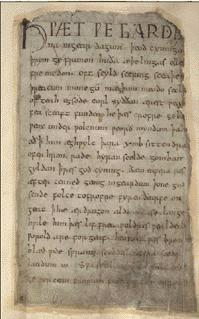| Group | Germanic (with Old Norse, Old High German, etc.), West Germanic (with Old Saxon, Frisian etc.) |
| Geography | Was born and spoken in England |
| History | Once a conglomerate of tribal dialects spoken by Angles, Saxons and Jutes on their invasion in Britain, the Old English language was formed after England was unified by Alfred in the 9th century. A lot of poems, including the Beowulf epic, historical and religious literature was written in Old English before the Norman conquest. After the 11th century, the Middle English period started. |
| Phonetics | Significant changes which the Old English phonetics undertook, included various mutations; a lot of diphthongs were formed. Vowel mutations, like i-mutation and others, are characteristic for the language. A lot of spirants existed in the language, which are sometimes not reflected in the orthography: e.g., the letter g could sound three different ways: like [j] in yellow, like [g] in gift, and like Greek [g]. |
| Nominal Morphology | The language was more or less archaic, with Indo-European declension types preserved. Three genders, two numbers (with dual only in pronouns: wit 'you and me', git 'you two'), and four or five cases existed. Thetre were also root stems which had an ablaut mutation: t - t 'tooth - teeth'. |
| Verbal Morphology | The verb had only two tenses - the present and the past preterite tense. There were three moods, all of them formed flectively. All strong verbs were divided into seven classes, each of them reflected certain vowel mutation in the root: such verbs are called irregular in today's English. Weak verbs formed their past tense without any ablaut, but adding the suffix -ed-. |
| Lexicon | English did not borrow much from Celtic languages, except certain place names. More loanwords existed from Latin sources, and even more from Danish in the Viking epoch. The multinational lexicon of English began to shape in the Old period, and finally made English a language with 70% of foreign words in it. |
| Writing | Runic alphabets, Latin alphabet |
| Close Contacts | Celtic from aboriginal tribes of Britain, Latin from Roman colonists, Danish from the 8th to the 11th century. |
| Sample | 896. On y ylcan gere worhte se foresprecena here geweorc
be Lygan .xx. mila bufan Lundenbyrig. za s on sumera
foron micel dl ara burgwara, ond eac swa ores folces,
t hie gedydon t ara Deniscana geweorce, ond
r wurdon gefliemde, ond sume feower cyninges egnas
ofslgene. za s on hrfeste a wicode
se cyng on neaweste re byrig, a hwile e hie
hira corn gerypon, t a Deniscan him ne mehton s
ripes forwiernan.
896. This same year wrought the aforesaid army a work by the
Lea, twenty miles above the city of London. Then in the summer
of this year, went a large party of the citizens. and also of other folk,
and made an attack on the work of the Danes; but they were there routed,
and some four of the king's thanes were slain. In the harvest afterward
the king encamped close to the
|
| Picture |  |
| More info |